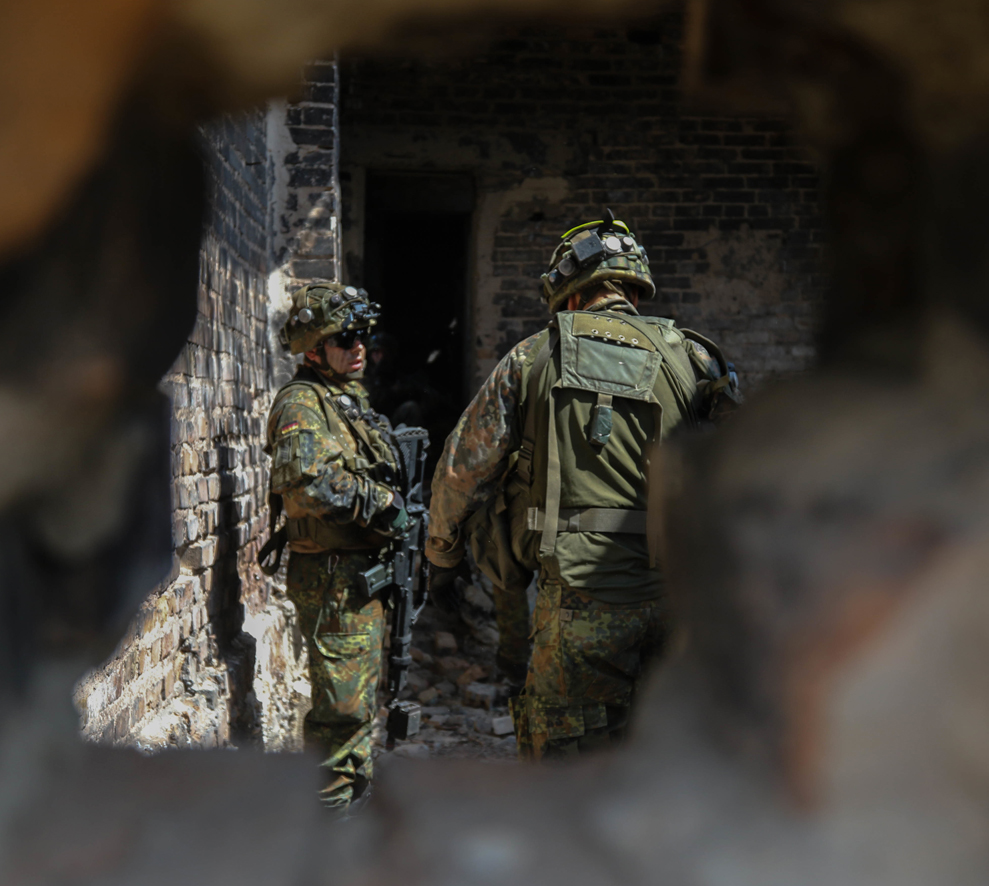Note: This study was prepared by Dr. Bahaa Al-Sabri, with the participation of researcher in military and security affairs, Dr. Firas Al-Rubaie.
Introduction
The global security environment is witnessing a state of instability due to asymmetric threats that have changed the traditional concepts of war, peace, and conflict at all levels. This shift has created what has become known as the “gray zone,” which has become a top priority for global security, as it has shown the ability to transcend the traditional theories that established the concept of force, as well as the methods of deterrence or control, including three theories that entirely depend on psychological and physical factors: Balance of Power, Balance of Terror, and Deterrence.
However, the emergence of asymmetric threats led to the creation of new types of threats, especially against security agencies and institutions around the world, as the theories, on which such institutions’’ means of defense were based, are helpless in the face of such threats, even anticipating them, the matter that prompted the world to search for new mechanisms.
The success of testing Deterrence Theory, in general, is through the theory’s basic variables success, which depend on credibility, assessment, and perception of the threat. Threats, and their nature, also play a role in evaluating deterrence success or failure. In light of the transformations taking place within the phenomenon of today’s threats, and the transition towards asymmetric threats, the international system has become facing a set of threats from multiple sources (actors from states or groups, internal, external or mixed domains, traditional and non-traditional means). This diversity confused the policies of countries to confront and anticipate threats, where states’ policies came to be incapable of predicting or confronting threats, or build deterrence policies capable of repelling these asymmetric threats. This paper is trying to answer this number of questions, the most important of which are: Will the traditional Deterrence Theory, with its components and conditions for its success, be able to face such new threat of threats? Will credibility, the nature of the adversary; and cost-and-profit calculations be determinants of today’s deterrent policies to be applied to asymmetric threats? Will State deterrence policies succeed in deterring asymmetric threats in the future?
Axis One: The Role of Deterrence in Confronting Asymmetric Threats
First: The concept of deterrence and methods thereof
Deterrence is a behavior governed by a set of actions, which include several conditions aimed at achieving certain ends. Deterrence defined as "using potential force, and persuading a potential enemy to avoid certain activities, for such avoidance would be in his best interest".
In the strategic-political sense, deterrence can be defined as the attempt of one party to prevent another party from ding an action, that the first party believes is harmful to itself, or to prevent the other party from thinking about doing a particular action, conduct, or behavior, that could pose a threat to the interests of the first party, its objectives, its position, or its status.
In the preventive sense, deterrence means the first party’s preparation and readiness to possess the capabilities, abilities, and means that prevent any hostile action, thereby provide evidences and proofs to the second party about the possession of the retaliatory capabilities, that ensures a strong response when any attempt to threaten the national security of the first party.
Deterrence consists of two main parts: physical deterrence, which includes all types of force and its tools that are sufficient to punish the adversary, and moral or psychological deterrence, which aims to psychologically influence the opponent by convincing him to surrender because not surrendering means consequences that the adversary cannot stand.
Thus, deterrence capabilities, at all levels, are based on given realities grounded on a set of material and moral strength elements employed at the appropriate time and place.
The Four Main Methods of Deterrence:
1- Deterrence through punishment: threatening the adversary with punishment if he takes actions that the first party opposes. This is the most common method. In fact, it is so widespread that some definitions of deterrence imply that it is the only method of deterrence. For example, in his 2003 book, “Deterrence Now,” international law scholar Patrick M. Morgan declared “The essence of deterrence is that one party prevents another from doing something the first party does not want by threatening the other party seriously.”
2- Deterrence through deprivation: threatening the adversary by depriving him of the advantages and interests that the other party granted to him or by influencing other parties to prevent them from presenting these interests to the opponent.
3- Deterrence through reassurance: convincing other countries of good intentions, which reduces the risk of provoking or forcing them to use violence in self-defense in response to efforts aimed at deterrence. This tactic was used by the great powers during the Cold War during arms control initiatives, including establishing recognized “red lines” that neither party may cross, , restrictions on nuclear weapons testing, and reducing the number of weapons through treaties such as the Strategic Arms Reduction Treaty (START) and Strategic Arms Limitation Talks (SALT).
4- Deterrence through temptation: providing new advantages or material or moral interests to the adversary if he abandons harming the interests of the other party.

Second: The Role of Deterrence in Confronting Asymmetric Threats
In the traditional Deterrence Theory, knowing the adversary’s desires to actually continue or decline is based on profit and loss calculations, but in light of asymmetric threats, the calculations of preference and perception of the opponent’s trends are unidentified or unknown, so it is difficult to determine such desires, the matter that weakens the tools and means of traditional deterrence. This problem has become the focus of attention for most researchers and specialists in political and security affairs.
Modern threats have shown difficulty in defining their features in a way that accurately describes them, the same applies on knowing what their limits and dimensions are, as they are the result of a set of variables that have established tactics radically different from traditional threats, as they rely on employing a whole range of different means used in warfare, including systemic capabilities, irregular tactics, and terrorist acts, including indiscriminate violence, coercion, and criminality.
A higher level of threat referred to in many studies is asymmetric warfare, which takes several forms that can be read in three levels: field, characterized by covert operations that depend on the element of surprise; military strategic, which includes guerrilla warfare or blitzkriegs; and strategic political, which includes wars with cultural, moral, or religious significance.
In a simplified manner, the asymmetric threat is considered (the explicit or implicit intention to interfere, harm, or punish the other party) and accordingly, the explicit or even the implicit threat to the state is regarded a security threat, as long as the goal of the threat is to inflict harm or interfere in the affairs of this state. The conditions for the threat actuality lie in the availability of three elements: (credibility, seriousness, and capabilities) that are directly proportional to the threat increasing its seriousness. There are three main features of the threat, namely: (severity, probability, and timing),
The asymmetric approach enabled weaker states or parties to possess the means of great harm, despite the weakness of their national strengths. Therefore, this approach is described as a “weapon of the weak” through which the weaknesses of the stronger party can be attacked and damage can be caused. In this case, the stronger party faces an unprecedented level of threat due to the following:
1- An unclear threat, in terms of the difficulty of assessing it and determining the damage it may cause to the state.
2- Threats become related to the instability of perception and the speed of its change between subjectivity or objectivity. This makes it impossible to know whether a party is a threat or not.
3- The traditional balance of power has specific features. While asymmetry differs in terms of the factors and levels that affect them in the international environment, the most important of which are states, organizations, economic institutions, and individuals.
4- The multiplicity of tools used in asymmetric threats, foremost of which is technology and cyber weapons.
Asymmetric threats are of a non-military nature and have undergone a rise in the post-Cold War period; by a large percentage, they come from non-international actors (regions, communities, and individuals); they affect the security of all actors; and they usually take the form of danger before such danger becomes a threat, making threats unmeasurable.
Axis Two: Deterrence and Threat Balance
It is the balance of power theory that constituted a key axis in explaining the phenomenon of international relations. It is also the theory which countries sought to create a state of relative balance that achieves equal gains. But in the midst of progress and the relentless pursuit of countries to adopt behaviors and policies that achieve the higher interest of their goals, trends have changed, and the quality and sizes of threats in the environment of the international system have increased. Based on this point of view, researchers in political and international affairs have focused on developing theoretical frameworks that explain the facts of events. This resulted in the emergence of what is known as the Balance of Threat theory introduced by Stephen M. Walt in 1985, which is based on the principle of gaining and maximizing power for the sake of threat only, not for defense.
The criterion between the Balance of Threat theory and the Balance of Power theory is the desire to possess the offensive and defensive powers. The interpretation of the two forces meaning can be explained according to the goals pursued by the states: the offensive force aims to balance the threat while the defensive force seeks to achieve the balance of power principle. Therefore, the outputs resulting and arising from the imbalance of power can be established to adopt the trends of Balance of Threat theory. The fact that the latter is a coercive and inevitable balance, gives the impression that if threats do not reach the level of balance, they will be security risks to the national security of states.
The first stage of the threat balance is very critical, as it is related to the process of recognizing and accurately identifying the threat. This establishes subsequent arrangements as perception is one of the most significant variables of the Balance of Threat theory. This stage requires a comprehensive briefing process of what the threats are in the surrounding environment, according to analytical models that determine the threat scale, level, degree of impact, and expected time period for the threat to turn into a threat that affects the national security system of a state.
In this regard, a unified view identifying the threat can develop a clear and comprehensive view of the capabilities and possibilities available to balance that threat. Here, deterrence will be one of the forms of this balance, either through the state’s possession of capabilities, resources, and elements of power, or through acquiescence and avoidance of threat and provocative measures raising the level.
Axis Three: Strategies for Anticipating Asymmetric Threats
After knowing the nature of asymmetric threats, the effects of their occurrence, and the extent of their impact on the national security of states, as well as on regional, international and collective security, states sought to develop a set of strategies to anticipate asymmetric threats to reduce their occurrence.
First: Recognizing Asymmetric Threat Sources
This strategy is one of the most important in anticipating a threat. It is centered on establishing the rules for dealing with what is perceived from asymmetric threats. The more comprehensive and accurate that perception, the more effective and complete the procedures necessary to remove the threat.
Based on the identification of inputs (threat sources), this strategy establishes a set of proactive foundations and policies, then deliberately analyzes the outputs. Thus, this strategy is based on two processes: ranking the sources of national security risks according to their importance and, second, studying the mutual effects between all national security risks for common areas based on the interaction of challenges, threats, risks, and weaknesses with one other.
The lack of knowing the common area of risks will make these risks difficult to resolve because they will establish their own cultures, behaviors, political commitments, and external interventions, as is the case in fragile states. Thus, the study concludes the identification of inputs starting with the operations phase within the systems analysis methodology.
Second: Precautionary Deterrence Strategy against Asymmetric Threats
This strategy focuses on expanding the scope of technical and technological capabilities, as well as expanding traditional physical and intelligence capabilities, in order to ensure a great deal of ability to deter any threats to the national security of states. Some developed countries with potential often follow this strategy by strengthening precautionary security and political measures to protect higher goals and interests.
Of course, precautionary measures are not new at the level of countries as they maintain their national security. However, what can be observed, at the state level, is the escalation of proactive measures in recent years, which is related to a number of dimensions, as follows:
1- The need to develop methodologies and means to deal with sudden and unexpected events, and take the necessary measures to anticipate their repercussions.
2- States are now resorting to strengthening precautionary strategies in the face of terrorism, as an alternative to pre-emptive wars, which have led to the increase of extremism and the spread of terrorist organizations.
3- Precautionary measures should include a combination of economic and cultural tools, in parallel with military and security tools.
The real understanding of the risk scale cannot be isolated from a real understanding of the environment elements the surrounding national security, and the associated threats, cannot be assessed for a risk itself in isolation from the source of such risk, and the targeting area in the prevailing circumstances. The risks and threats, to national security, cannot be accurately concluded, unless the elements of the surrounding environment the risks as a general context are understood, and then apply the appropriate methodology to assess these threats in their asymmetric pattern, leading to arrange a list of risk priorities.
Third: Electronic and Cyber Deterrence and Defense Strategy
The cyber deterrence strategy provides a general description of the defensive capabilities of countries that are spending more of their resources to deter the growing cyberattacks in recent years by securing resilience in both defensive and offensive networks.
The focus of the cyber deterrence strategy is the ability to resist cyberattacks by strengthening cyber capabilities that protect state infrastructures. This strategy is described as flexible and capable of preventing hostile actors from launching cyberattacks in the first place.
Cyber deterrence is carried out through the development of counterstrategies through which an adversary realizes that if he launches an attack through cyberspace, he will be confronted with another counterattack that exceeds his capabilities, such as, for example, targeting cyber infrastructure, communication systems, financial and banking systems, or cutting off internet services. The adversary is thus deterred from launching or repeating the attack.
An example is when internet communications in North Korea was cut off three times in late 2014 after North Korea allegedly hacked Sony Pictures Entertainment’s computer system, which cost the company an estimated $15 million, in retaliation for its production of a comedy film centered on a plot to assassinate North Korea leader Kim Jong Un.
Not all cyberattacks are equally important: not every attack can be deterred and not every attack amounts to national security threats. The lesson for policymakers is to focus on the most important attacks and to understand the context in which they may occur by putting a full range of mechanisms available to prevent cyber-attacks. But, as former Estonian President Toomas Hendrik Ilves observed, the biggest problem with cyber deterrence remains deterrence itself. U.S. presidential advisor Richard A. Clarke and former White House director for cybersecurity Robert Knake agree, arguing in their 2021 book, “Cyber War: The Next Threat to National Security and What to Do About It,” that “of all concepts of nuclear strategy, deterrence is probably the least convertible to cyber warfare.”

Ilves and Knak also argue that the United States' heavy reliance on cyber communication makes it particularly vulnerable to asymmetric cyberattacks in the real world, so the United States should be deterred from embarking on a full-scale cyber war, for fear of the disproportionate effects retaliation could have on American networks.
This leads us to build a scientific perception that understanding deterrence in cyberspace is often difficult, because the concept of deterrence, derived from the Cold War, was embodied in deterring a nuclear attack through another nuclear counterattack.
In contrast, many aspects of cyber behavior are similar to other behaviors, such as crime, where deterrence in cyberspace, like punishment and deprivation, may be effective. More important than deterrents, however, is the ability to recover from the effects of cyber attacks and threats.
Fourth: Strategy for Anticipating and Managing Information Risks And Protecting The External Environment
The essence of this strategy is to protect the external perimeter by looking for vulnerabilities within operating systems, browsers, and web servers, where potential malicious code can be identified by recognizing signatures and patterns. Although this strategy enables traditional defensive measures such as software repair, secure tuning, and fixed perimeter protection, these measures are not enough to thwart sophisticated and ongoing attacks.
Most countries have worked to follow and adopt a set of strategies in anticipation of asymmetric threats, as they are characterized by complexity and the element of surprise. Therefore, these strategies work to mitigate and eliminate the effects of asymmetric threats.
Axis Four: The Future of Deterrence and Asymmetric Threats
After ensuring that deterrence is relevant in all forms of confrontation—whether in conventional wars, wars of control, electronic control, or asymmetric threats—the future effectiveness of deterrence, in light of the increasing frequency of asymmetric threats, will be more difficult. Hence, future extrapolations are determined to change the concept of deterrence, according to the nature of asymmetry in the threat.
The future of deterrence, in light of asymmetric threats, will be determined by other matters, foremost of which is the weaknesses of states that do not have the capabilities to face asymmetric threats. These countries are directly affected by any regional or international variables because they cannot protect their internal security environment or their external interests.
In addition, deterrence in asymmetric threats requires assessing the source and nature of the risk because such deterrence is related to the nature of the capabilities possessed by the source of risk. It is also related to assessing national capabilities and the abilities of allies since they contribute to playing a major role in deterring asymmetric threats. The idea of the alliance here does not depend on increasing the level of power in the first place, but rather increasing the level of influence and deployment, and enhancing the ability to respond quickly to deter asymmetric threats.
At a meeting of the alliance in December 2015, NATO adopted a multidirectional strategy to counter asymmetric threats, such as information sharing, early warning systems to sense threats, and work to identify vulnerabilities that represent a threat attraction case.
A risk coming from an international coalition takes the most weight in terms of danger, while a risk coming from a neighboring country takes less weight. And a risk coming from internal or external organizations takes the smallest percentage of all.
It is important to estimate the possible time period for the risk since this estimation will determine the time needed to prepare and be ready to confront such a risk. The higher the occurrence of the risk probability is, or the closer it is to the present, the higher the risk scale. Vice versa, an imminent risk that can occur at any moment occupies priority and is followed by the rest of the possibilities.
There are risks that occur only with the availability of certain and special circumstances, and the probability of their occurrence is related to those circumstances. The significance of deterrence in future extrapolations remains the decisive factor for determining the credibility and awareness of the potential capability to bring about the action in a certain place and at the right time. Such response will be multifaceted, the highest of which is threatening a counterchallenge and perhaps a parallel challenge, or trying to agree and be in obedience to the challenger’s demand in a way that prevents him from operating the elements of action, the matter that leads to changing the rules of confrontation and turning them into less powerful means.
On the other hand, asymmetric threats will be in the face of deterrence capabilities, and thus the capabilities and abilities used, specifically weapons, may vary according to the type of results desired from the deterrence strategy in a given matter. Deterrence is characterized by the existence of a strategy to threaten punishment to convince the opponent that undesirable behavior will cost him much more in losses than may result in gains. Deterrence should be credible. Sometimes the effectiveness of deterrence lies in the amount of power it possesses, whether militarily or political and economic power.
The Future of Developing Deterrence Capabilities against Asymmetric Threats
The asymmetric threat assessment process is extremely complex due to the many variables that should be taken considered or the considerations that cannot be overlooked since they can affect the digital values of security risks. Based on the above, the directions of mechanisms for developing deterrence capabilities to counter asymmetric threats in the future can be identified.
- Enhance diverse deterrence capabilities that are appropriate to asymmetric sources of threat as well as their changing nature.
- Strengthening joint cooperation programs with preventive measures that enable deterring the threat of actors from those that affect national, regional, and international security.
- Increasing the degrees of cognitive awareness of deterrence programs, in proportion to the scale and impact of asymmetric threats.
- Achieving the principle of balance in the threat, in a way that constitutes a deterrent element for both parties, and discouraging the will to harm any party at the expense of the other party.
- Giving the issue of force in its traditional, electronic, and moral sense a new dimension consistent with the adoption of deterrence capabilities that undermine asymmetric threats.
Conclusion
Recent developments in technology, weapons, political, and media methods have enhanced the ability of asymmetric threats to maintain a measure of influence. The selectivity used by asymmetric threats makes conventional—or even nuclear power—be incapable of being a deterrent. This selectivity, in particular, focuses on the vulnerabilities of states in an attempt to make the desired impact of the threat.
The dimensions of asymmetric threats included a number of variables that differ from threats between neutral parties. The actors that implement the threats are unequal, as well as the inability to know their limits and mechanisms in order to reduce and deter their risk. Hence, these threats were in the crosshairs of deterrence theories.
Nevertheless, the latter theory has acquired another meaning imposed by the asymmetric threat environment, which led to the adoption of unconventional deterrence strategies and is characterized by its ability to significantly reduce the seriousness of asymmetric threats. On the other hand, the Balance of Threat theory is one of the most important intellectual proposals in the field of international and strategic studies, framed by practical practices by active states through all levels (individuals, institutions, organizations, companies, states, and alliances) to achieve a new form and pattern of deterrence practice against asymmetric threats. These practices will be effective to achieve the desired goals of deterrence. In addition to that, the strategies used in deterrence will depend on special tactics consistent with the nature and impact of asymmetric threats.
Keep in touch
In-depth analyses delivered weekly.

Related Analyses:











